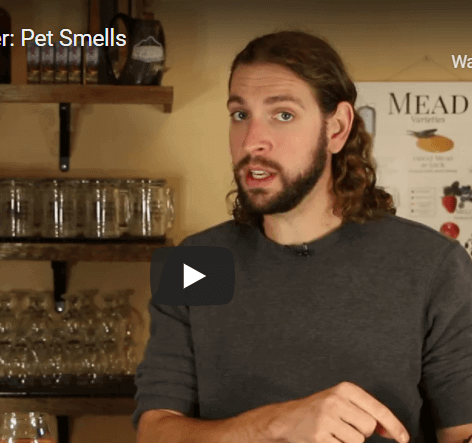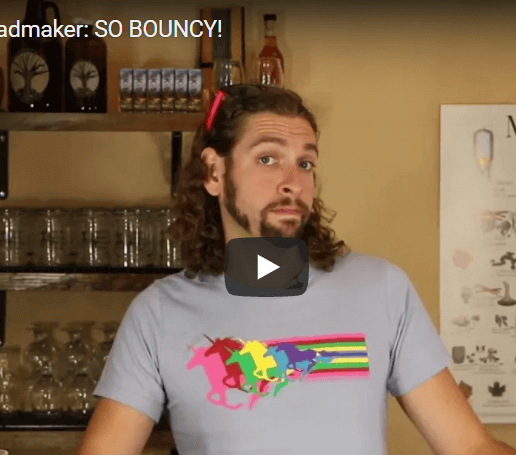In which Ricky the Meadmaker answers questions about adding chocolate to mead, water filtration and temperature, Campden tablets, SO2, and more!
A while back, I think we did this cold open, and I showed you all what the rest of our mead hall looks like when we're not looking over at me behind the bar. I think you will all be happy to know that it's a mess. It's still a mess. But it's a different mess from last time, which is a form of progress.
Welcome to Ask the Meadmaker, where I, Ricky the Meadmaker, answer your questions about mead making, mead drinking, mead brewing, and really any question you're willing to send to me.
Our first question this week comes from Dennis, who explains that he's in Ireland. I think it's nice that he told me where he's from, because then it doesn't seem crazy that everything he wrote was in metric. Anyway, he wanted to know some of the specifics about our production here. He was trying to glean our production process from past episodes and things we said online. And he wanted to know about carbon filtration of water and the temperature to which we heat that water, and, most importantly, the order in which we do those things.
Well, the first piece is, we no longer carbon filter our water coming in. The water quality here in Colchester, Vermont is so good that we're able to just get away with diatomaceous earth, which means that I have a much faster flow rate, which makes brew days faster. We filter first, then, at this time of year, being, I don't know, the fall or something, we only heat our water to 98˚F, which is some different temperature in centigrade, but the same temperature in an absolute sense. Anyway, 98˚F. Look it up on Google if you use metric. That way, we never really heat the honey hot enough that we're driving off the volatile flavors and aromas.
Our next question comes from William, who is distraught. William is part of a growing list of individuals whose meads appear to be ruined. Stuck fermentations. His stopped before it was finished and he wanted to know if possibly using Campden tablets at the beginning of his fermentation is part of the problem. Now, Campden tablets are a way to sulfite your mead to kill the wild yeast. He wanted to know if that might have a prolonged effect on his mead. The answer is, it oughtn't to, but only if you do it right. If you throw in Campden tablets at the beginning, and somehow you don't wait long enough, or you put in more than you intended, what can happen is you can kill off not only the wild yeast, but a portion of your intentionally pitched yeast, reducing its overall viability, and possibly leading to a stuck fermentation.
Speaking of yeast, we switched our yeast. After three years of using a house strain, I decided that it was more trouble than it was worth and I'm back to D47.
We actually got this next question twice this week. One time it was in English, and one time it was in Spanish. I am going to opt to answer it in English, hoping that my answer applies in both languages. The question was, how do we put chocolate in mead? Now, there are two big ways to add chocolate flavor to a fermented beverage. One is cocoa nibs. The other is an extract of some sort. Some people will also use cocoa powder, but then it can sludge up things and it's a big nuisance. The reason we don't use cocoa nibs is when you throw them in one of my big tanks, they settle to the bottom and they gunk stuff up about as badly as cocoa powder.
What we could do is take those cocoa nibs, put them in ethanol, pure vodka, let's say, and then pour that extraction into our tank. Or, we could let someone else do that for us and just buy pure cocoa extract, which is what we do.
Azazeal took my advice on the cat pee question from a few episodes ago, he thinks he's figured out where the cat pee aroma in some mead comes from. He believes it comes from SO2, and he wanted to know how that SO2 would get into solution in the first place. The answer is excessive sulfiting at bottling time.
Our last question this week is one of those extremely serious ones we get from time to time. Throughout the course of our show over the last few years, periodically, someone will make mention of the dreaded alcohol, methanol. Someone will say, "You can't use fruit, you can produce methanol." They will say, "Now, you need to be very careful about fermenting at high temperatures. You'll create methanol." None of this is true. Methanol only occurs from a very specific type of fermentation, usually known as wood fermentation. You cannot get it in quantities capable of harming human beings from anything you would reasonably ferment, from barley and beers, to honey and mead, to apples and cider. Methanol does not occur in the fermentations you are doing at home. And although home distillation is illegal for most of my viewers, if you were to distill your product, you still wouldn't make methanol. Distillation is a concentrating technique. It concentrates the ethanol. It does not produce a new material. So, of the many, many, many things you can worry about in home brewing, making methanol is not one of them.
That's our last question this week. I just need to send it over to Ricky with our word of the week. Ricky.
Thank you, Ricky. This week's word is balché. It is a mead brewed in Mexico by the descendants of the Mayan people, and unfortunately, it was banned in the name of Christendom. Now I am rather partial to mead, and even I can admit that this isn't the worst thing ever banned in the name of Christendom, but it's still a damn shame. Balché. It was fermented in a canoe. It's our word of the week and the end of our show. Keep sending your questions and I'll get to them as soon as possible. Cheers.




